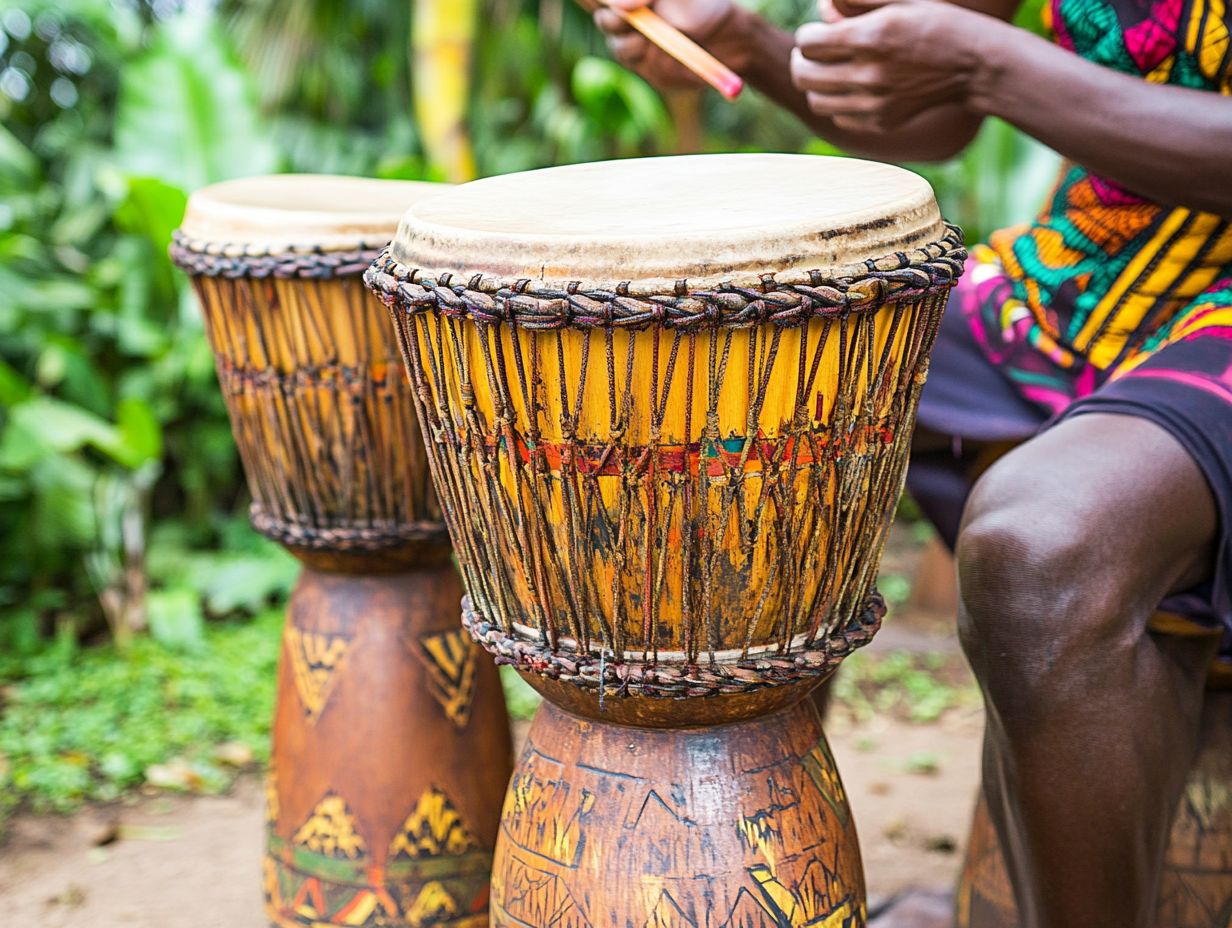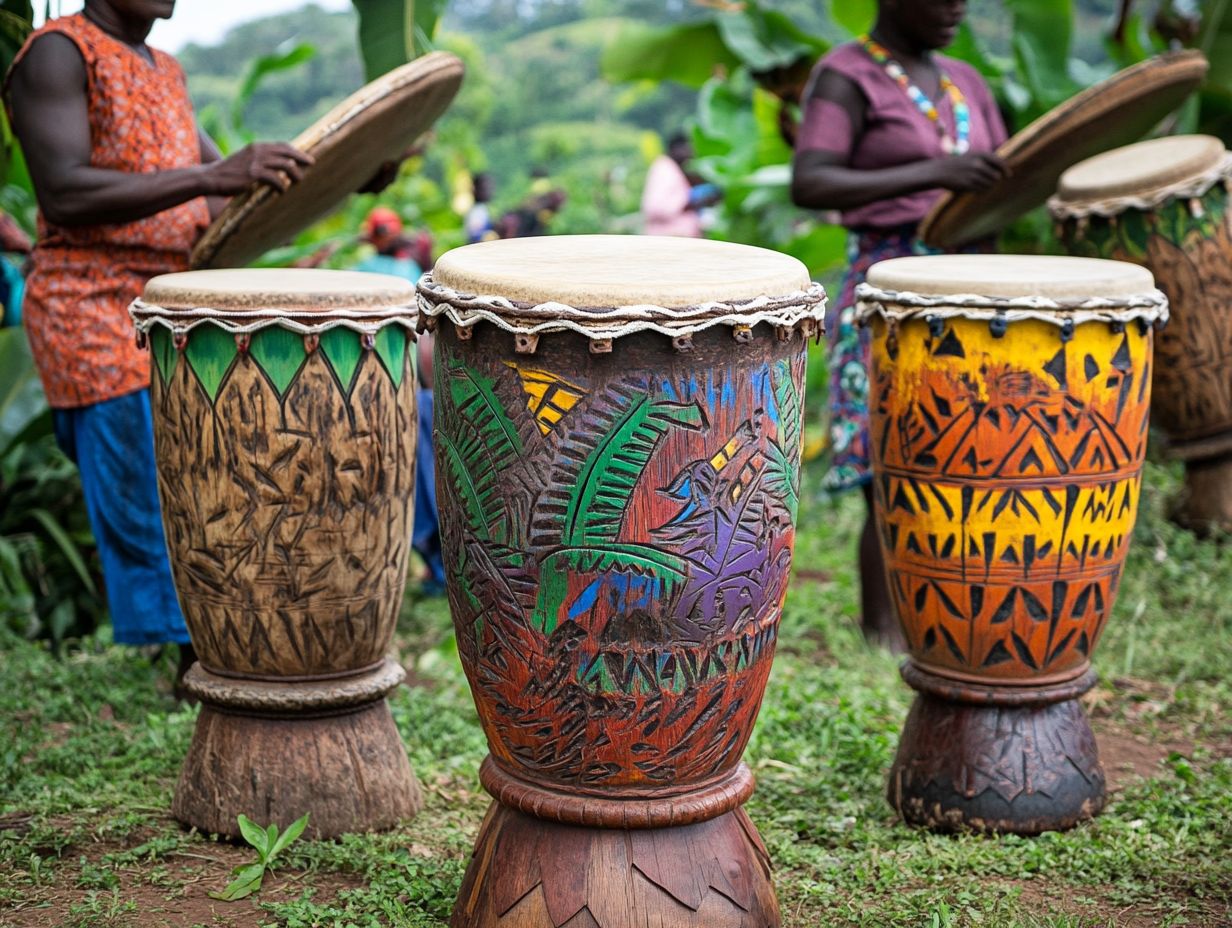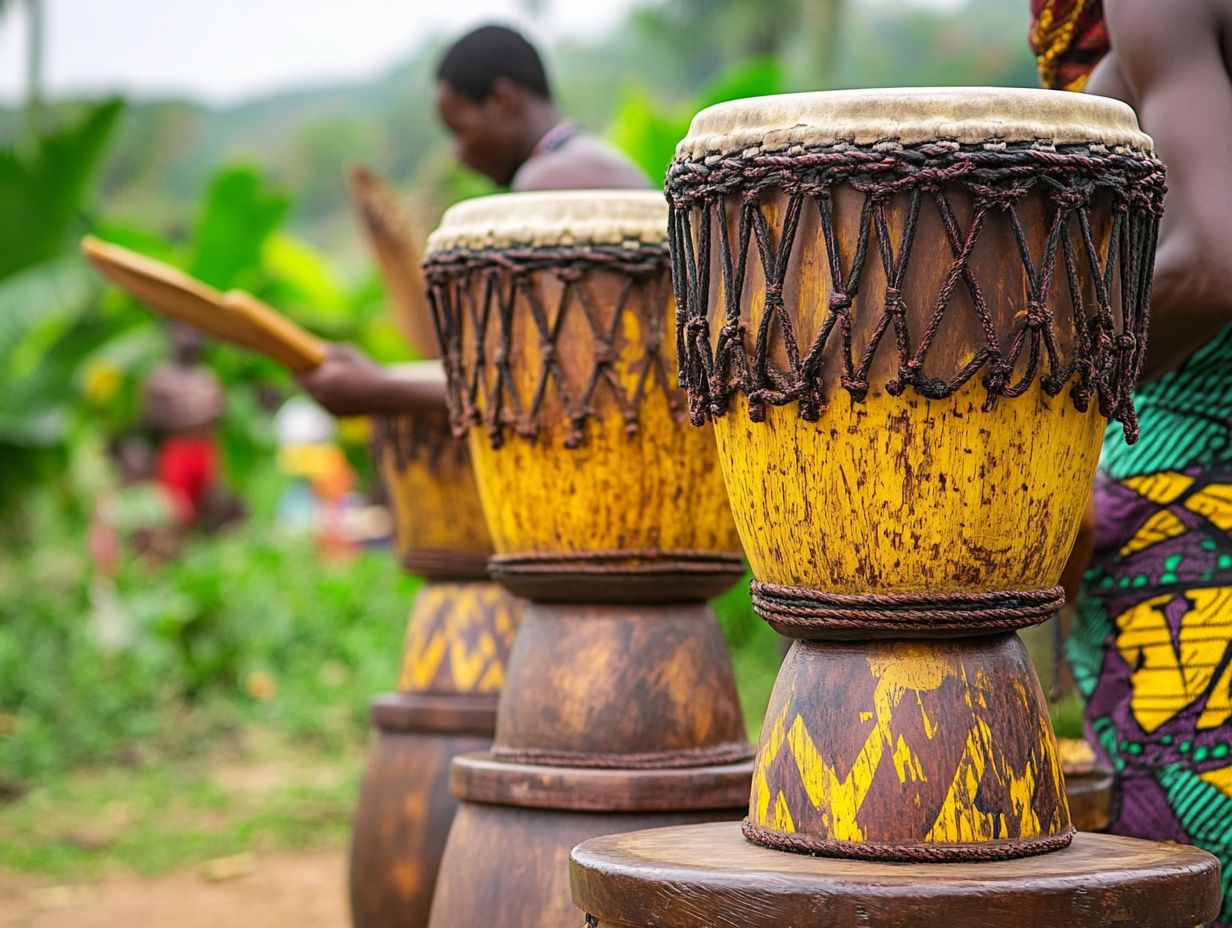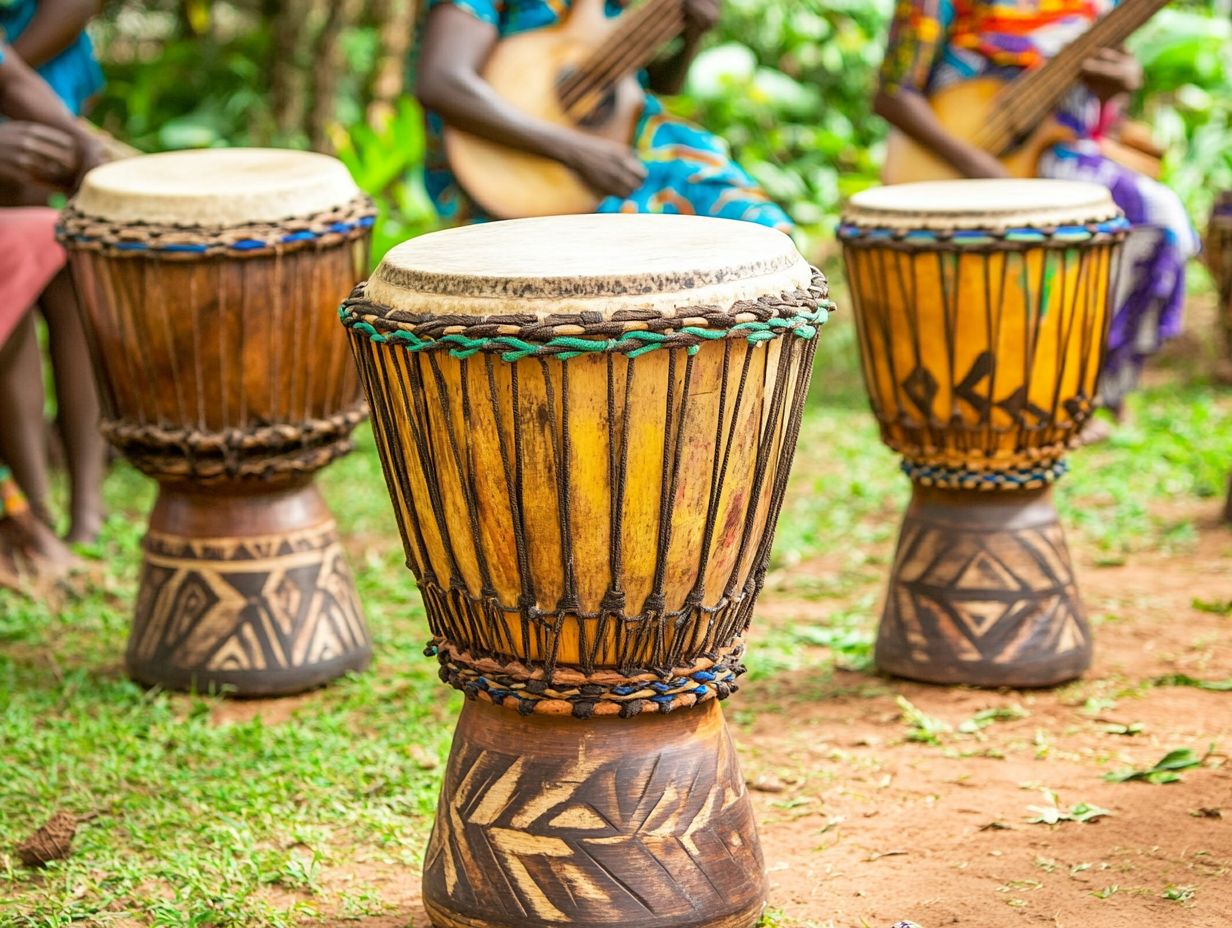Traditional African drums are not merely musical instruments; they are vibrant vessels of cultural heritage, history, and community.
Explore the diverse types of drums, their unique characteristics, and the intricate playing techniques that bring them to life.
Discover the rich rhythms that have shaped modern music, and learn how these powerful sounds are intertwined with traditional ceremonies.
Whether you are a novice or a seasoned musician, we will share valuable resources for learning and preserving these remarkable art forms.
Join us in celebrating the distinctive tones and textures of traditional African drumming and its enduring significance in today’s world.
Contents
History and Cultural Significance

The history and cultural significance of African drums reflect the continent’s rich diversity in cultures and traditions. Throughout history, rhythmic patterns have been intricately linked to social gatherings, community rituals, and spiritual practices. Drums such as the djembe, talking drum, and conga serve as powerful vehicles for musical storytelling, making them essential cultural artifacts that express and preserve the oral traditions of African peoples.
Folk traditions surrounding African drums illuminate the evolution of African culture and its influence on contemporary music. From ancient ceremonies honoring ancestors to modern celebrations that bring communities together, drumming has become an integral part of everyday life for many African peoples. Influential figures, often regarded as master drummers, have transmitted techniques, rhythms, and narratives that encapsulate the essence of indigenous sounds.
Significant historical events, such as the transatlantic slave trade, disrupted these traditions but also led to the emergence of new genres like Afrobeat and reggae, where ancestral rhythms were adapted and revitalized. The role of the drum extends beyond mere entertainment; it serves as a powerful symbol of resilience, connecting the past to the present through its deep ties to identity and spirituality.
Different Types of Traditional African Drums
Traditional African drums encompass a diverse range of drum types that vary in sound, size, shape, and purpose, contributing to the rich tapestry of rhythms and sounds in African music.
Some of the most widely used percussion instruments include:
- djembe
- talking drum
- conga
- bongo
- frame drums
The djembe is a goblet-shaped drum capable of producing both deep bass tones and high-pitched, sharp sounds. The talking drum is named for its ability to mimic human speech by altering the pitch of its tonal sound.
Conga and bongo drums are frequently used in ensemble music to create intricate rhythmic patterns. Frame drums, such as the ngoma, tbel, and bendir, are generally more melodic than other traditional African drums and are often featured in solo performances or smaller music gatherings.
Collectively, these drums play a vital role in shaping the sound of African culture.
Description and Characteristics
African drums are percussion instruments known for their distinctive tones and complex sound dynamics, which define the rhythmic patterns of traditional music across the African continent. Each type of drum possesses unique qualities; for instance, the djembe has a resonating body that produces a range from deep bass to high treble, while frame drums offer versatile tones that easily fit into various musical genres.
The craftsmanship of these instruments reflects centuries of cultural transmission, with skills passed down from generation to generation, preserving the rich heritage of African drumming. Typically made from a combination of hardwoods and animal skins, these materials significantly influence the drums’ acoustic properties.
For example, the choice of wood can affect resonance and volume, while the tension of the drumhead determines pitch and tonal quality. Different playing techniques, whether using hands or sticks, add further dimension to their sound, creating a rich auditory experience that captivates audiences and transforms these percussion instruments into vital expressions of cultural identity.
Playing Techniques and Styles

The playing techniques and styles of African drums reflect the rhythmic complexity and cultural richness of the continent’s traditional music. Drummers utilize a range of techniques, including polyrhythms and improvisation, to produce intricate rhythmic patterns that engage both the drummer and the audience.
These performance techniques are passed down through oral tradition and experiential learning, highlighting the communal bonds formed in drum circles and festivals.
In these gatherings, both beginners and experienced musicians come together to celebrate their culture through rhythmic and sound experimentation.
Traditional Rhythms and Patterns
Rhythms and patterns in African drumming are highly diverse and reflect the continent’s rich linguistic and cultural tapestry. These rhythms serve as the foundation for various musical genres throughout Africa, including pop, jazz, traditional ethnic music, and dance. Afrobeat, arguably the most influential musical genre to emerge from Africa in the past century, is characterized by its complex, layered, and polyrhythmic structures. Often referred to as timelines or pulses, these rhythms typically have specific purposes, such as accompanying dance or celebratory music, and frequently play a ceremonial role.
Beyond mere entertainment, these rhythms are essential to how many communities organize their social lives and express their spirituality. For instance, the distinct timeline of the djembe—a goblet-shaped drum from West Africa—is used during gatherings to convey messages. The Kpanlogo rhythm from Ghana is associated with happiness and vigor, often featured during community celebrations. The Gahu rhythm is performed during ceremonial gatherings and drum circles to foster unity and harmony among participants.
In Cuba, the Danzon de la Vida rhythm is played at wedding ceremonies, highlighting the romantic aspects of the occasion. Similarly, the Tonkori rhythm from Kazakhstan is utilized during engagement rituals, with one drummer playing while the other performs a traditional dance. Other rhythms also serve communal purposes, such as the ceremonial Stylized War Rhythm from Congo, which marks transitions between life phases through rituals, and the Enuma rhythm from the Democratic Republic of Congo, played during funeral ceremonies to honor the deceased.
Moreover, the Afunhaya rhythm from Nigeria is used in traditional rites of passage, while the Isikolo rhythm from South Africa is performed at funerals to ease the transition to the afterlife. The diverse rhythms of African drumming exemplify how the continent’s music preserves cultural identities, connects individuals to their ancestors, fosters a sense of belonging, and maintains continuity across generations.
Influences on Modern Music
The influence of traditional African drumming extends well beyond the continent, shaping modern music across a wide range of genres and cultures worldwide. Elements of African rhythms, such as syncopation and polyrhythms, have been woven into various musical styles, including jazz, rock, contemporary Afrobeat, and world music, thereby enriching the auditory experience for listeners.
Festivals that celebrate these cross-cultural influences often showcase the fusion of traditional sounds with modern instrumentation, highlighting the enduring legacy of African drums in today’s musical expressions. For example, artists like Aaron Neville and Paul Simon have heavily drawn from African drumming techniques, infusing their work with unique rhythmic patterns that create a rich soundscape.
Genres such as hip-hop and electronic music also reflect the impact of African heritage, with producers incorporating iconic drum sounds reminiscent of traditional ceremonies.
Major music festivals, such as the Harare International Festival of the Arts and the Cape Town International Jazz Festival, serve as vital platforms where artists from diverse backgrounds gather, exchange ideas, and experiment with innovative collaborations, ensuring that the rich tapestry of African rhythm continues to resonate within global music culture.
Exploring the Sounds of Traditional African Drums

Exploring the sounds of traditional African drums involves understanding the tones and soundscapes produced by various instruments across the continent. The rich, deep tones of the djembe and the melodic sounds of frame drums contribute unique auditory aesthetics to African music, allowing for a diverse range of expressions of African musicality.
This exploration of traditional African drum sounds highlights the musical artistry of drumming while also conveying the emotions and stories often expressed through these instruments.
Distinctive Tones and Textures
The diverse sounds and textures of traditional African drums are shaped by various factors, including the materials used, the techniques of play, and the cultures that utilize them. Each percussion instrument possesses unique vibrational properties that generate musical rhythms and facilitate interaction between sound and movement. The rich tones of drums like the talking drum and djembe are not only vital for musical expression but also serve as a reflection of the intricate cultures from which they originate.
For instance, the djembe, crafted from carved wood and covered with goat skin, produces deep, resonant bass sounds when played with the palms, while higher notes can be generated using the fingers. The variations in tension and thickness of the drumhead significantly influence its pitch and resonance. The talking drum, played with a curved stick, mimics the tonal patterns of speech, adding to its communicative quality. Together with advanced playing techniques such as slapping, tapping, and pulling, these instruments create a complex sound that conveys deep emotions and historical narratives.
Common Uses in Traditional Music
African drums have various common uses in traditional music, including folk celebrations, traditional ceremonies, and community rituals. They are often played to convey messages, tell stories, or invoke religious significance.
In dance music, drums provide the rhythmic foundation that unites participants during traditional dance events. Additionally, African drums play a crucial role in strengthening social ties within communities, fostering a sense of belonging and identity. For example, the talking drum, used by the Yoruba ethnic group in Nigeria, is played at social gatherings to relay news and bring the community together.
The Djembe drum, a widely recognized African drum, is commonly played during traditional ceremonies. These ceremonies, such as marriages, initiations, and funerals, incorporate specific rhythmic patterns that evoke emotions related to the events and help participants connect with their cultural history and ancestry.
Furthermore, drums are integral to many traditional entertainment events, including storytelling, praise singing, and theater, where they create ambiance. Drumming also plays a formative role in strengthening social ties between generations during these entertainment events. For instance, during hunting storytelling sessions, elders use drums to generate excitement and thrill while recounting their experiences.
Thus, African drums serve not only as a source of entertainment but also as an important medium of education within the community.
Learning to Play Traditional African Drums

Learning to play traditional African drums offers a rich experience that combines music education with cultural transmission, providing beginners with a unique opportunity to engage with vibrant musical heritages.
Many drumming workshops and community classes provide resources to teach foundational drumming techniques, rhythms, and improvisational skills, encouraging individuals to embrace the art forms of their ancestors. Through these educational experiences, participants not only learn the technical aspects of drumming but also gain an understanding of the cultural significance and storytelling elements behind the music.
Resources and Techniques for Beginners
For beginners, numerous resources are available for traditional African drumming that emphasize foundational techniques and cultural heritage. Instructional materials, online tutorials, and local music schools incorporate improvisation and rhythm techniques, enabling new learners to develop their skills in an engaging and culturally relevant manner.
Aspiring drummers can further their education by participating in community workshops and cultural events, where they have the opportunity to learn directly from experienced musicians. These interactive experiences deepen one’s understanding of various drumming styles while highlighting the role of rhythm as an expression of cultural identity.
Learners can practice keeping tempo with metronomes and play-along tracks, as well as experiment with different rhythms. This hands-on approach fosters a nurturing environment for artistic growth, encouraging individuals to explore personal expression within the broader context of music education.
Preserving and Promoting Traditional African Drumming
Preserving and promoting traditional African drumming is essential to the cultural heritage and legacy that has characterized the African continent for centuries. Various initiatives aimed at preservation are contributing to the long-term maintenance of this art form, including community involvement, educational programs, and cultural exchange initiatives.
These efforts are vital for ensuring that the rich sounds and rhythms of African drumming continue to flourish, allowing future generations to appreciate and benefit from them. By fostering an appreciation for traditional drumming and its cultural significance, communities can enhance their identities and strengthen social cohesion.
Efforts to preserve and share cultural heritage related to traditional African drumming encompass a wide array of initiatives designed to foster understanding and appreciation of these art forms. Community rituals, intergenerational practices, and collaborative projects play a significant role in transmitting traditions, ensuring that the knowledge and skills associated with drumming are handed down through generations.
By engaging diverse audiences in these preservation efforts, communities not only celebrate their heritage but also contribute to a broader global dialogue on cultural diversity and artistic expression.
These initiatives often include workshops, performances, and educational programs that encourage participation from individuals of all age groups, nurturing a sense of belonging and pride. Through the rhythmic pulse of drums, participants connect with their ancestral roots, rediscovering stories and customs that reinforce their identities.
Collaborating with local schools and cultural organizations enhances community engagement, attracting individuals who may not have previously interacted with these traditions. Ultimately, the collective effort to promote and sustain drumming practices fosters resilience, ensuring that the vibrancy of these cultural expressions continues to thrive for future generations.
